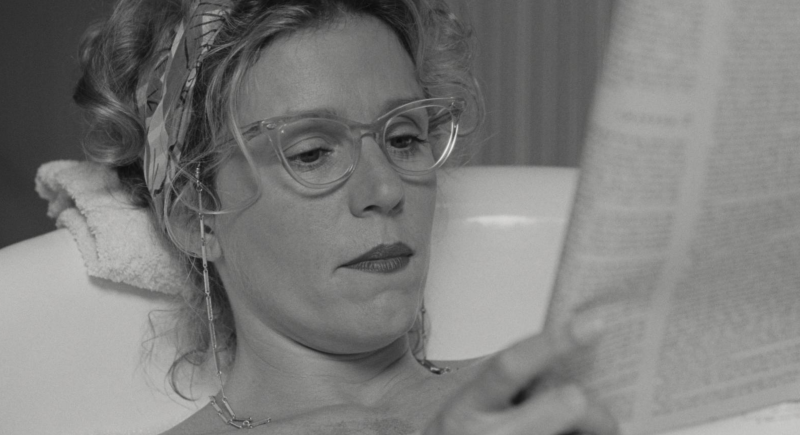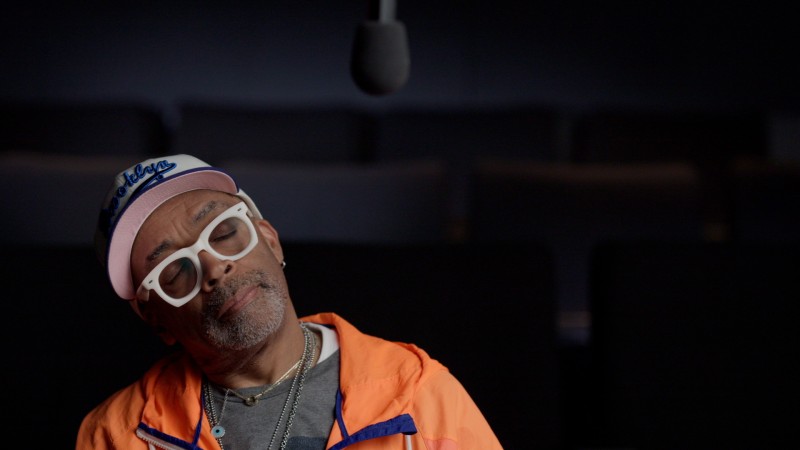Both filmmakers came to Neza with a desire not just to direct or observe, but to collaborate. Pablo, along with another local leader nicknamed Rafa Punk, appear in the credits of Shit Saturday as production assistants, while the script is attributed to the Mierdas Punk Collective. The film offers a portrait of the gang drawn as much from their giddy fantasies as from their marginalized daily lives. This isn’t just any day for the Mierdas Punk. While the rest of Mexico celebrates Holy Saturday, these kids are out to desmadrar, a Mexicanism that roughly translates as “go wild,” “party,” or “fuck shit up.” Looking for a ride to that night’s concert, they commandeer a garbage truck and pile into its empty cargo tank, banging ecstatically on the metal cylinder. At the show, they stream into the crowd, where Rocha captures them moshing in balletic slow motion—footage so electric that Minter worked it into Nobody Is Innocent as well.
The set piece conveys the disruptive force that punk represented in Mexican society. Rock music had arrived decades ago, entering the nation’s bloodstream through middle-class consumption and working-class migration patterns alike. In a country where a one-party state went hand in hand with a strong official nationalist culture, rock and roll offered an alternative idiom of youth rebellion, one that blended into the student movement whose demands for democracy were repressed by the Tlatelolco massacre of 1968. Rock lived on, but after the Avándaro music festival of 1971, often referred to as Mexico’s Woodstock, triggered backlash—the right saw drugs and decadence, the left saw encroaching American cultural imperialism, and the forces of repression saw a potential new community for the student movement to regroup among—it was driven underground. The ruling Partido Revolucionario Institucional (PRI) shut down concerts, censored radio, and put pressure on labels to stop releasing rock records. The regime’s aim was to modernize Mexico on its own terms, keeping a tight control on media and aiming to shape consumption habits from above. Punk veteran Francisco “El Iti” Valle (his nickname derived from E.T. the Extra-Terrestrial) complained of this dynamic to anthropologist Carles Feixa: “It’s disgraceful how the government, through Televisa, comes out saying: we won’t allow people into this country with exotic ideas, which they call foreignizing, talking about nationalism, when they’re constantly showing commercials for Coca-Cola, or telling us to smoke this tobacco from that multinational, which is much more foreignizing, much more colonizing.” As rock was criminalized and its torch passed to the dispossessed, underemployed people of the urban fringe, it became a vehicle for contesting globalization from below, borrowing and reworking music and fashion from abroad in a Mexican idiom.
By the 1980s, that urban underclass was especially desperate and its youth receptive to the even more incendiary gospel of punk rock, particularly the rabidly nihilistic, antiauthoritarian strain unleashed in the UK by the Sex Pistols. The “Mexican miracle” that had propelled economic growth in the decades after World War II had long dried up, a brief oil boom had turned to bust, and the 1982 debt crisis had sent the peso plummeting. For those coming of age on the city’s margins, punk music’s nihilism had an obvious logic: “If society wants to destroy me, I won’t give it the pleasure, I’ll destroy myself,” in Iti’s words. “Punk rock has the vitality that rock and roll had in the fifties, when it broke with the establishment and with morality . . . We chose punk rock because it became so questioning and authentic, it reclaimed the rebel spark of rock and roll.”
Albums by the Sex Pistols and Ramones began circulating in Neza, with photos in imported rock magazines contributing to the groups’ allure. “Above all it was the look,” says Pablo. “Changing the way you dressed: ripped pants, ripped T-shirts, leather jackets with punk badges, chains with padlocks.” Punk fashion provided new possibilities for individual expression. “The idea for the punks was to be original,” as Iti put it, “put on a rag, add a rip, a zipper, make it look unique.” Conversely, it also cemented the collective identity of youth gangs like the Mierdas Punk. These groups sprung up as territorial units, but often became differentiated along musical lines, each declaring allegiance to a particular style. Though turf disputes between the gangs generated violence, belonging to one afforded members a certain protection from the threats of the others, a valuable asset in the era’s deteriorating urban climate.
Born of a merger between several smaller youth gangs, the Mierdas Punk boasted as many as six hundred members by the mideighties. Subdivided into local chapters—such as Pablo’s Aguiluchos, based in the neighborhood of Las Águilas—the group became something like a federation of Neza’s punks. Shit Saturday often plays like a cinematic zine, an opportunity for the Mierdas to express themselves on their own terms, celebrating an identity that had only appeared in the Mexican media as a bogeyman demonized in the tabloid press. Here they have the chance to show off their fashions, dance to their music, and voice their opposition to the prevailing social order. That doesn’t mean they sanitize themselves; amid the cascade of moshing bodies at the film’s concert centerpiece, real violence breaks out when a punk is stabbed. Conflict spills out into a street melee, pitting punks against rockers, and letting the Mierdas demonstrate their valor in combat. When the cops arrive, though, there’s no choice but to flee (“If the pigs come, we will fucking run away from them!” one punk exclaims earlier in the film, his braggadocio charmingly undiminished), and sirens pursue sprinting teens through the grainy dark. The gangs manage to set fire to a squad car in the confusion—suggesting some imaginative behind-the-scenes bribework on the filmmakers’ part—and the appearance of a common enemy brings punks and rockers together in hiding, reminding them where the true social battle lines are drawn.
In Shit Saturday’s final images, the punks regroup at dawn atop one of the mountains that ring Mexico City. As a pinkish sunrise swells over the horizon, two of the kids mount a crucifix, likely erected for that week’s Good Friday celebrations. “I am the Antichrist!” one of them shouts, quoting Johnny Rotten. This finale’s jubilant symbolism runs deeper than mere sacrilegious provocation. As the writer Sergio González Rodríguez observed, when the Spanish invaders seized central Mexico from the Aztecs in the sixteenth century, they imposed a Christian value system on its geography, constructing churches and monasteries on high. The resulting “law of the high and the low”—which associates altitude with purity, health, and beauty; and lowlands with vice, disease, and sexuality—has shaped Mexico down to the present day. In seizing the heights for the film’s triumphant daybreak finale, the Mierdas reject Easter solemnity in favor of a different kind of holiday, a carnivalesque inversion of the everyday hierarchy that insists that their place is down below.
“Though they’re punks, with all the violence of the gangs, at the same time they’re sweethearts,” Rocha Minter observes of the Mierdas. It’s hard to forget, watching these films, that these are kids. There’s something touching in their puerility, and their attitude toward the camera is that of children thrilling to the novelty of being recorded: self-conscious enough to demand attention, unselfconscious enough to issue that demand in crudely espoused slogans, acts of heedless self-definition. They’re quick to brawl, but on camera there’s a playfulness to their fisticuffs, and insult comedy, or carrilla, is clearly a language of in-group affection (“You’re a fucking abortion” serves as a friendly greeting). If their drug use, or their acts of aggression and self-harm, seem shocking, it’s worth remembering what they were up against. The Mierdas had to hustle precarious work—wiping windows, repairing cars, selling candy, making house calls like the one that brought Pablo to Rocha and Minter’s door—from a tender age. El Iti was one of about sixty members of the gang incarcerated in a police roundup during the period when Rocha and Minter were filming, and his account stresses that the police subjected minors to torture and rape. Like the street kids of Luis Buñuel’s Los olvidados (1950), their world had no place for childhood.
Hence the title of Minter’s Nobody Is Innocent, which captures the dead-end social conditions that gave rise to the Mierdas’ nihilism. Whereas individual personalities barely emerge from the kinetic rush of Shit Saturday, Minter’s portrait is built around a central protagonist, the teenage Kara, who boards a passenger train to nowhere at the beginning of the film, leaving his punk comrades behind. As he heads into the countryside, his voice-over leads him back through memories of Neza: “The streets are cool and full of stones . . . the houses are dirty and full of lice but comfortable.” Observational scenes of the Mierdas’ daily lives intrude as flashbacks. They live in overcrowded cement houses, often without running water, amid unpaved streets. What glimpses of family life we see are hostile. Intergang violence lurks with deadly tension, no longer looking quite so much like a spirited team sport. Minter takes keen interest in the gang’s punk philosophy and rituals: Pablo holds court amid a group of younger disciples; Iti riffs wittily on a cartoon mocking popes and presidents; a group of Mierdas “baptize” a pipsqueak nicknamed Cebollas in a shower of spit at the junkyard. But the gang’s ideals are only fleetingly realized, more often remaining out of reach. Kara complains that the Mierdas’ best days are behind them, and plays with the idea of refounding a gang of true punks. Another Mierda narrates a dream to two friends that sounds a lot like the climax of Shit Saturday, a desmadre too badass for this world.
It’s no wonder that Kara boards a train out of town, even if he has no idea where he’s going. Perhaps he’ll wind up crossing the border to find work in the U.S., as many of the Mierdas wound up doing temporarily or permanently. Minter imagined the possibility of escape once again in Alma Punk, a portrait of a young woman named Alma (Ana Hernández) who leaves the Mexico City punk scene for the U.S. When it came to filming the border-crossing scene though, reality upended Minter’s scenario. “Ana was going to start to jump over the wall,” remembers Paula Capra, Minter’s close collaborator. “And she jumped and didn’t come back.” Having lost access to their lead actor, Minter and Capra had to shift their plans, even redubbing her voice with Capra’s in some scenes. This surprise, however, wound up helping convey Alma’s yearning appetite for new horizons, and deepening the film’s unstable mix of fiction and documentary. The character’s simulated passage into the unknown had become a real one for the actor.







